Nelumbo nucifera Gaertn.
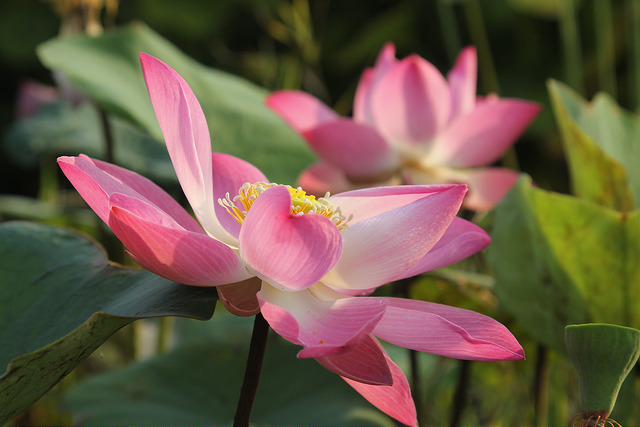
Photo credits to Ang Wee Foong
USES
Symbolic
“Upright and steady, concentrate in mind, perfected for this hour by countless lives spent in the search of Truth and the Good Law, the child took seven steps, resting the soles of his small feet firmly upon the grass, where seven lotus flowers full-blown sprang forth, bright as the Seven Stars near the North Pole. This sign discerning, the Great Kings that guard the quarters four of the earth, came down from heaven and ‘fore the royal child prostrating low with folded hands, placing his tiny feet upon their heads, then rising, stood aside, each in the allotted quarter, his domain.”
James Arther, The Way of the Buddha. An ideal. I-III [14]
The symbolic origin of Nelumbo nucifera came from Egypt, where it represented “the sun and of life, of immortality and of resurrection” and had an important association with the sun gods Horus, Atum, and Osiris [15].
Highly regarded as the national flower of India, the Sacred Lotus held deep religious significance to Hindus and Buddhists and was likewise a symbol of the sun [15]. The lotus flower represents “beauty, purity and divinity”, and is also a symbol of fertility [13],[16]. The purity of the Sacred Lotus comes from the fact that its flower blooms above the water, never touching the mud [15].
In late Hindu literature, the goddess Padma (Lotus) was mentioned and largely “worshipped by the peoples of the rice-producing section of India” [15]. Her features described were all lotus related and was said to grant wealth, livestock, slaves - thus bestowing longevity and prosperity to her people [15].
Numerous animals are also associated with the lotus flower. They include: “The Cow, Ram, Lion, Phoenix, Sphinx, Deer, Gazelle, Ibex, Wild Goat, Fish, Bird, Hare, Elephant, and Horse” [15]. Celestial and mythical Beings such as the Makara “are directly associated with the lotus as part of the water cosmology of early Hindu and later Buddhist India” [15].
Food [4]
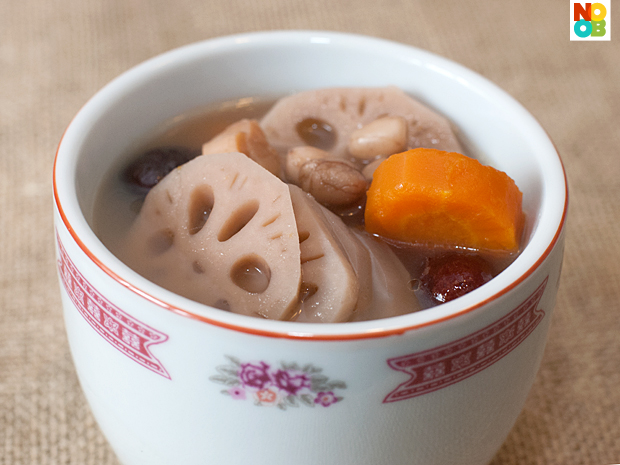 |
 |
Mostly present in Southeast-Asian cuisine, the young leaves, leaf stalks and flowers can be eaten as vegetables. The rhizomes, or the lotus root, is used as a vegetable in soups or stir-fried. The lotus seeds can be eaten raw, dried, or boiled with dried longans for dessert.
A paste can also be made from the lotus seeds, and is commonly used as an ingredient to make mooncake and rice flour pudding. The large leaves of Nelumbo nucifera are also used to wrap food such as lotus rice.
Medicinal
In traditional Chinese Medicine (TCM), the root of Nelumbo nucifera has been categorized as cool with cold properties, and sweet-tasting [17]. Based on the “basic theory of five elements (Wu-Xing)” and its relationship with “organ-specific channel tropism” [17], various parts of the Nelumbo nucifera has been present in oriental medicine to cure fever and sweating [18]. Its leaves are also considered a traditional Chinese herb that has been recently used as an ingredient in dieting tea in China [19]. The seeds are used to preserve the body’s health and strength as a tonic, and the rhizomes (after cooking) are used to treat “sunstroke, diarrhoea, dizziness, vomiting of blood and haemorrhoids” [4].
In recent studies, the leaves of Nelumbo nucifera was found to have alkaloids and flavonoids that displayed significant anti-HIV activity as well as “hepatoprotective and antioxidant effects against chemically induced liver damage” [15],[20]. Furthermore, other studies have shown that Nelumbo nucifera leaves extract also “impaired digestion, inhibited absorption of lipids and carbohydrates, accelerated lipid metabolism and up-regulated energy expenditure” [19]. Although its leaves have many medicinal properties, the rhizomes of Nelumbo nucifera has also previously shown to have anti-inflammatory activity [20].
NOMENCLATURE
Etymology
Nelumbo = derived from the Sinhalese word Sinhanlese: නෙළුම් neḷum,nucifera = (latin) bearing, producing or containing nuts [1]
Nelumbo nucifera is an accepted name [2].
Recent synonyms[2],[3]
Nelumbium nelumbo (L.) Druce; Nelumbium speciosum Willd; Nelumbo speciosa Willd; Nelumbo caspica (Fisch.) Schipcz.; Nelumbo caspica Fisch.; Nelumbo komarovii Grossh.;(See scientific classification.)
Past synonym: Nymphaea nelumbo L.
Common names [3],[4]
Sacred lotus; Lotus; East Indian lotusDESCRIPTION
Habit [4],[5]
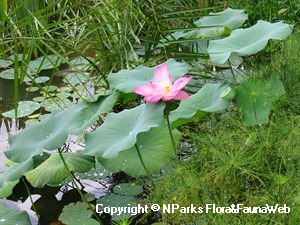
Photo credits to NParks Flora & Fauna Web
Nelumbo nucifera is a perennial aquatic angiosperm that grows as an herb. Its large, peltate leaves typically grow 1-2 m above the water surface from a horizontal rhizome that grows in the mud at the bottom of shallow water bodies.
Leaves [4],[5],[6],[8],[9]
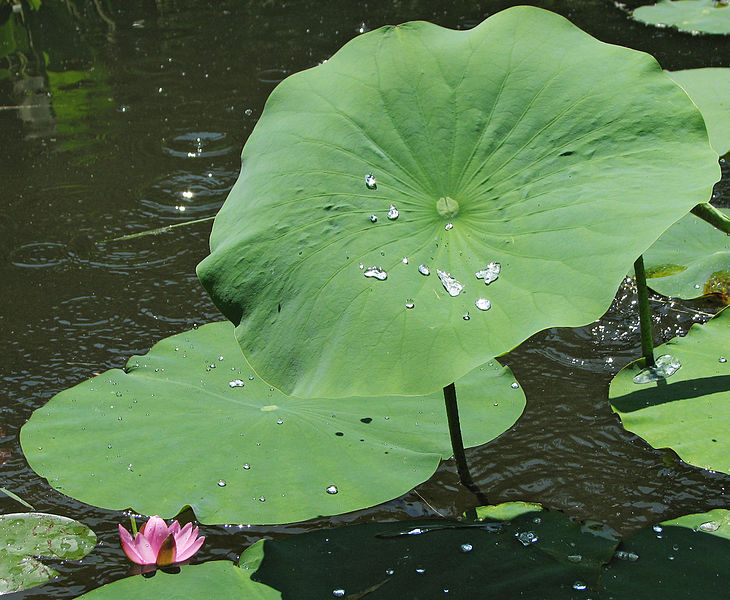
Photo credits to Innerpath
The leaf blades of Nelumbo nucifera are simple, entire, and suborbicular. They are flat when floating and somewhat cupped when emersed. Each leaf is water-repellent and peltate due to the waxy coating on the adaxial surface. The leaves have radiating veins branched dichotomously except the midrib. The petiole is 1-2 m long and scattered with hooked spines. The leaves are 20-90 cm across and are alternately arranged.
Flower [4],[5],[6],[7],[8],[9],[10],[12]
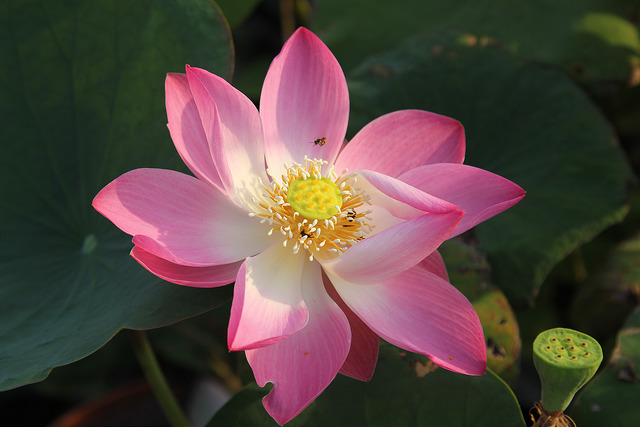
Photo credits to Ang Wee Foong
The solitary and terminal flower of Nelumbo nucifera is rose-pink or white and fragrant. It is typically 8-25cm in diameter and is bisexual. The preduncle is 2 m long and the petiole is 1-2 m long. In each flower:
- Sepals are ovate or elliptic, 1.5-5 cm across and 0.8-3.5 cm long
- Each petal is elliptic, obtuse or subacute, concave, 4-15cm across and 2-8cm long
- The corolla is pale yellow
- Stamens up to 225, each 2.5-4.5 cm long
- Terminal stigma
- Yellow anthers 1.2-1.5cm long with a conspicuous fleshy 0.5 cm long appendage
- The gynoecium is superior and apocarpous, with usually 15-20 uniovulate carpels
(See pollination and symbol.)
Fruits [8],[9],[12]
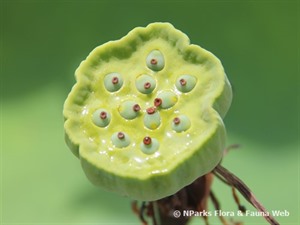 |
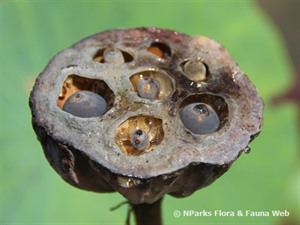 |
The nuts are an ellipsoid or ovoid, hard-walled and are 1.0-2.0 cm x 7-15 cm in dimension. They are yellow during anthesis and dark brown to blackish when ripened. They are usually embedded in the enlarged receptacle and are non-fleshy.
(See dispersal.)
Rhizomes [4],[5]
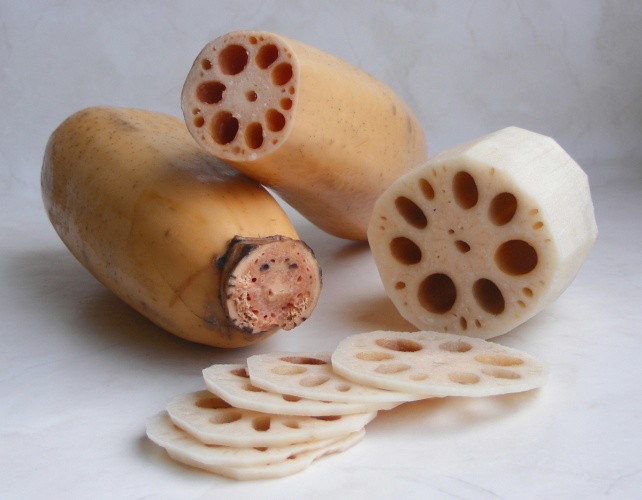
Photo credits to Innerpath
A rhizome is a modified stem which the roots of Nelumbo nucifera grow from. They grow beneath the mud in shallow wetlands and are branched, repent, forming swollen terminal storage tubers.
Seeds[4],[5],[6],[12]
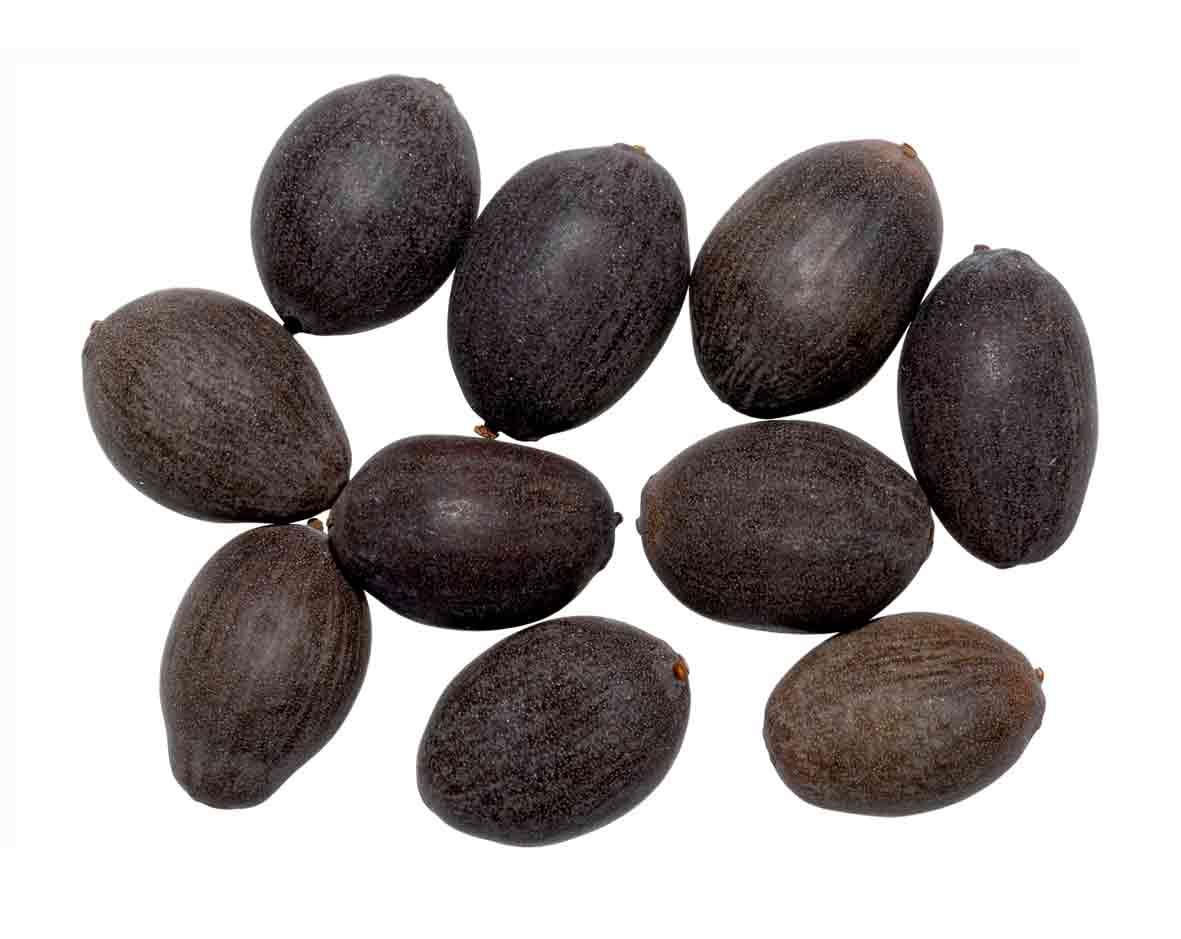
Photo credits to Kew Science
With the permission of the Trustees of the Royal Botanic Gardens, Kew
There are numerous seeds in one fruit that are fleshy and enclosed in a stipule-like sheath. The pericarp is thick and hard, and the seeds are indehiscent. The seeds are also able to maintain extreme longevity, germinating after 1000 years or longer.
BIOLOGY
Growth and Phenology
Nelumbo nucifera seeds are often planted between “late spring and early summer with plant growth ending in the fall under natural conditions” [24]. Other environmental factors such as “genotype, media, water depth, temperature, fertilization” etc. affect the growth and yield of the lotus.
Nelumbo nucifera can be propagated and cultivated from its “seeds, rhizome divisions with viable growing points, and tissue culture” [24].
Ecology
Pollination
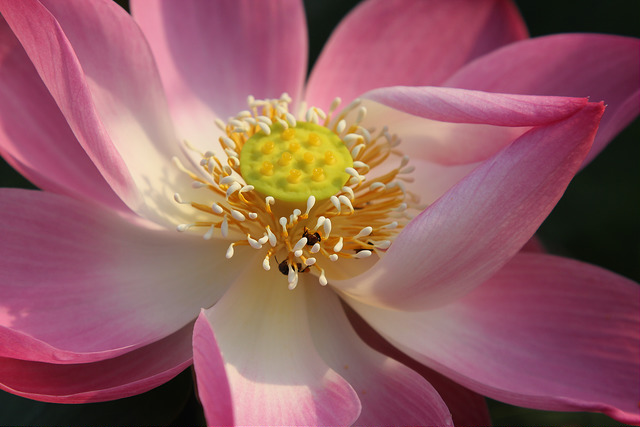 |
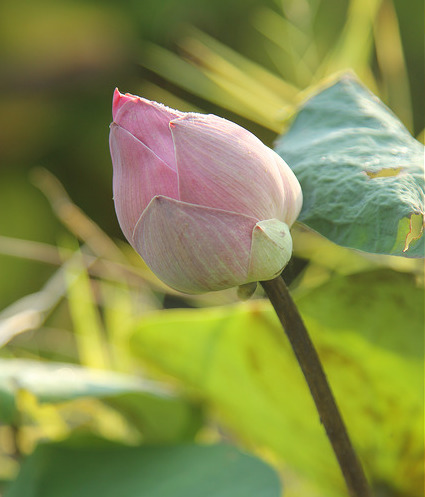 |
The flowers of Nelumbo nucifera exude thermogenicity by “self-heating” its receptacle that maintains a “relatively favourable temperature between 30 and 36 C when the surrounding temperature fluctuates between 10 and 45 C” [11]. Because of its thermoregulatory ability, the large flower provides beetles and bees with a warm night shelter, thus being a type of “beetle-pollinated chamber blossom” [11]. As the flower opens in the day, a variety of insects are able to access the flower, which are then rewarded with large pollen [11].
Effective and specific pollinators of Nelumbo nucifera are currently unknown [10], but studies have shown that bees and beetles are important pollinators in some populations in Nelumbo lutea [11].
Dispersal
The seeds of Nelumbo nucifera are dispersed via water due to their “buoyant structure that is well adapted to flotation” [12].
Natural Habitat
Nelumbo nucifera grows naturally in warm temperate to tropical climates [4], in “ponds, pools, rivers, (shallow) lakes” [1] and even extending to “lagoons, marshes, swamps and the backwaters of reservoirs [4].
Nelumbo nucifera is able to withstand waterlogged soils such as paddy fields [8] and prefer full sunlight [4].
DISTRIBUTION
Native range
Asia-Temperate [5],[13]
China
Japan
Hong Kong
Also cultivated.
Status in Singapore
Nelumbo nucifera is non-native to Singapore and is cultivated in Hong Kong [4],[6].
SCIENTIFIC CLASSIFICATION
| Angiosperm Phylogeny Group IV System |
Linnaean Hierarchy [3] |
Cronquist System of 1981 |
| Kingdom: Plantae |
Kingdom: Plantae |
Kingdom: Plantae |
| N.A |
Subkingdom: Viridiplantae |
N.A |
| N.A |
Infrakingdom: Streptophyta |
N.A |
| N.A |
Superphylum: Embryophyta |
N.A |
| Clade: Angiosperms |
Phylum: Tracheophyta |
Phylum: Magnoliophyta |
| N.A |
Subphylum: Spermatophytina |
N.A |
| Clade: Eudicots |
Class: Magnoliopsida |
Class: Magnoliopsida |
| N.A |
N.A |
Subclass: Magnoliidae |
| N.A |
Superorder: Proteanae |
N.A |
| Order: Proteales |
Order: Proteales |
Order: Nymphaeales |
| Family: Nelumbonaceae |
Family: Nelumbonaceae |
Family: Nymphaeaceae |
| Genus: Nelumbo |
Genus: Nelumbo Adans. |
Genus: Nelumbo |
| Species: nucifera Gaertn. |
Species: nucifera Gaertn. |
Species: nucifera Gaertn. |
The genus Nelumbo was previously categorized under the family Nymphaecaeae (and order Nymphaeales) due to the morphological similarities between both families [12]. Often confused with water lilies (genus Nymphaea), older systems recorded the lotus as Nymphaea nelumbo. Nelumbo was later recognized under a separate family Nelumbonaceae based on its “seeds with large embryo and abundant endosperm” and Nelumbonaceae was recognized under the order Proteales after differing in diagnostic features such as “tricolpate pollen grains, the structure of embryo, the presence of special respiratory openings in the pericarp and seed coat, the absence of lactiferous tubes and idioblasts, and the morphology of chromosomes” [9],[12].
TAXONOMY
Diagnosis
A proper species diagnosis is crucial when distinguishing members within the same plant family and genus.Family
Diagnostic features of family Nelumbonaceae are the same as Nelumbo nucifera [8]. They include [5]:
- Perennial aquatic herbs
- Branched rhizomes from which the alternately arranged leaves arise from
- Solitary flowers that are bisexual and hypogynous
- Nut-like fruit
- Seeds without endosperm and perisperm
Adapted from Flora of Hong Kong [8].
Genus
Nelumbo the only living genus out of 5 genera that have gone extinct. Fossil records indicate 4 extant genera - Nelumbites, Exnelumbites, Palenelumbo, and Nelumbago [22].
Species
Currently, there are two known alive species from Nelumbo - Nelumbo nucifera and Nelumbo lutea, and one extinct species - Nelumbo aureavallis [22].
Similar to Nelumbo nucifera, Nelumbo lutea is known as the American lotus and native to North America [23]. While its morphological characteristics and habits are similar to the lotus flower, its flower colour is pale yellow instead of pinkish-white [24].
=
LITERATURE AND REFERENCES
=
- Wiart, C. (2006). Medicinal plants of Asia and the Pacific. Boca Raton: CRC/Taylor & Francis. p33-36
- The Plant List
- Integrated Taxonomic Information System - Nelumbo nucifera Gaertn.
- NParks Flora and Fauna Web - Nelumbo nucifera.
- Wiersema, J. H., & Fu, D. (2001) Nelumbonaceae Dumortier. //Flora of China 6: 114//
- Hajra, P. (1996). Flora of India, Volume 1. Calcutta: Botanical Survey of India. p441-442
- Endress, P., & Friis, E. (1994). Early Evolution of Flowers (p. 109). Vienna: Springer Vienna
- Hong Kong Herbarium & South China Botanical Garden. (2007). Flora of Hong Kong, Volume 1. Agriculture, Fisheries and Conservation Department, Hong Kong. p68
- Qaiser, M. (n.d.). Flora of Pakistan.
- Vogel, S., & Hadacek, F., (2004). Contributions to the functional anatomy and biology of Nelumbo nucifera (Nelumbonaeceae) III. An ecological reappraisal of floral organs. Plant Systematics and Evolution. 249: 173-189
- Li, J. K., & Huang, S. Q., (2009). Effective pollinators of Asian sacred lotus (Nelumbo nucifera) contemporary pollinators may not reflect the historical pollination syndrome. Annals of Botany. 104: 845-851
- Hayes, V., Schneider, E., & Carlquist, S. (2000). Floral development of Nelumbo nucifera (Nelumbonaceae). International Journal of Plant Sciences, 161(S6), S183-S191.
- Kew Science, Plants of the Worth online - Nelumbo nucifera Gaertn.
- Arther, J., (1943). The way of the Buddha. An Ideal. I-III. [A poem]. Madras: Vasanta Press.
- Ward, W. E., (1952). The lotus symbol: Its meaning in Buddhist art and philosophy. The Journal of Aesthetics and Art Criticism, 11(2): 135-146
- India Development Gateway, Vikaspedia - National Symbols.
- Weng, W., & Chen, J., (1996). The eastern perspective on functional foods based on traditional Chinese medicine. Nutritional Reviews 54(2): 11-16
- Kashiwada, Y., Aoshima A., Ikeshiro, Y., Chen, Y-P., Furukawa, H., Itoigawa, M., Fujioka, T., Mihashi, K., Cosentino, L. M., Morris-Natschke, S. L., & Lee, K-H., (2005). Anti-HIV benzylisoquinoline alkaloids and flavonoids from the leaves of Nelumbo nucifera, and structure-activity correlations with related alkaloids. Bioorganic & Medicinal Chemistry. 13: 443-448
- Ono, Y., Hattori, E., Fukaya, Y., Imai, S., & Ohizumi, Y., (2006). Anti-obesity effect of Nelumbo nucifera leaves extract in mice and rats. Journal of Ethnopharmacology. 106: 238-244
- Huang, B., Ban, X., He, J., Tong, J., Tian, J., & Wang, Y., (2010). Hepatoprotective and antioxidant activity of ethanolic extracts of edible lotus (Nelumbo nucifera Gaertn.) leaves. Food Chemistry. 120: 873-878
- Mukherjee, P. K., Saha, K., Das, J., Pal, M., & Saha, B. P., (1997). Studies on the Anti-Inflammatory Activity of Rhizomes of Nelumbo nucifera. Planta Medica 63: 367-369
- Hickey, L, (1977). Stratigraphy and Paleobotany of the Golden Valley Formation (Early Tertiary) of Western North Dakota. Boulder, Colorado: Geological Society of America. pp. 110 & Plate 5.
- Go Botany - //Nelumbo lutea// Willd.
- Lady Bird Johnson Wildflower Center - //Nelumbo lutea//
- Tian, D., Tilt, K. M., Sibley, J. L., Woods, F. M., & Dane, F. (2009). Response of Lotus (Nelumbo nucifera Gaertn.) to Planting Time and Disbudding. HortScience 44(3): 656-659